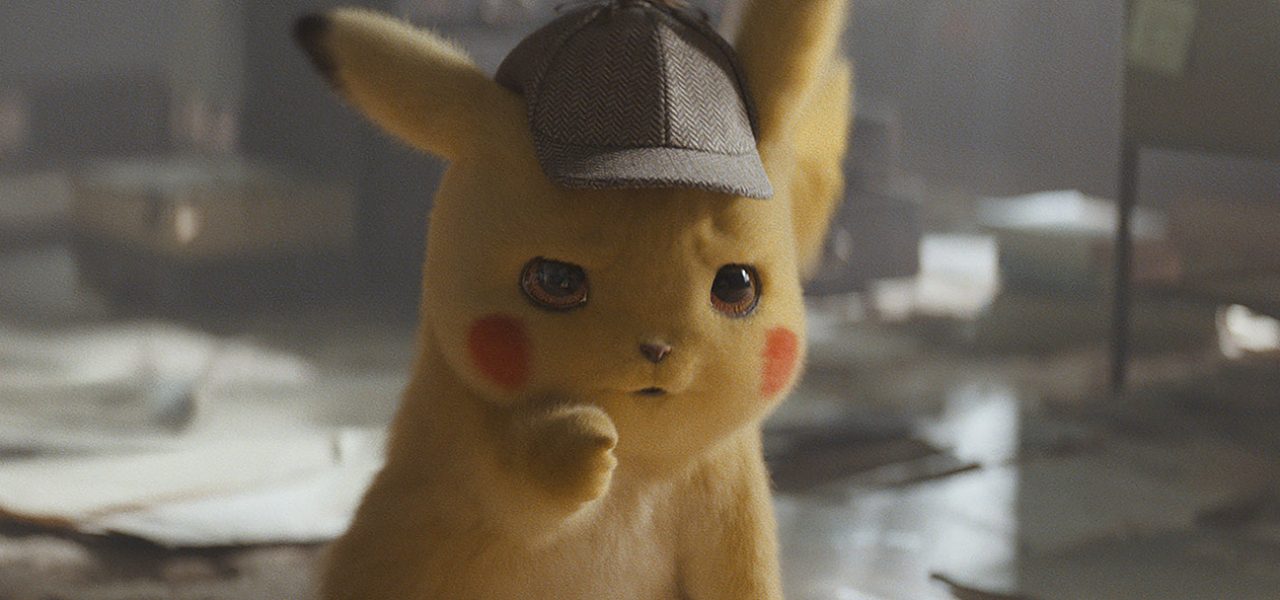
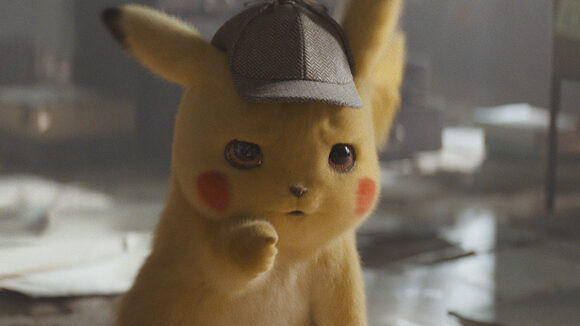
‘Detective Pikachu’ VFX Supervisor Erik Nordby On The Huge Challenge Of Translating Pokémon Into CG
As recent events have proven, transforming beloved characters from their original incarnations in 2d into 3d beings is a challenging task. In the case of Warner Bros. and Legendary Entertainment’s Pokémon Detective Pikachu, the pressure to satisfy nostalgic audiences was intensified by the involvement of the Tokyo-based Pokémon Company, which is, understandably, protective of their characters and related IP, and aims to retain the mythology and aesthetic of the hundreds of pokémon that make up the creative universe.
Director Rob Letterman (Shark Tale, Monsters vs. Aliens) and his vfx team, lead by production visual effects supervisor Erik Nordby, had to translate not one but dozens of creatures (65, according to Norby) into believable cg versions with specific textures, colors, and lighting that would integrate with the flesh-and-bone elements of this hybrid adaptation.
Four vfx companies were involved in the making of the legion of pokémon seen in Detective Pikachu: MPC, Framestore, Image Engine, and Instinctual VFX. To learn more about the meticulous operation to create a uniquely large number of cg critters and the strategy to remain faithful to the source material, Cartoon Brew spoke with Nordby (who’d previously worked with Letterman on 2015’s Goosebumps) about the rigorous creative pipeline and the intricacies of keeping Pikachu’s tail just as Pokémon devotees remember it.
Cartoon Brew: An impressive quality of the film, which surely fans appreciate, is how faithful the cg versions of pokémon are to their 2d animated incarnations. What were some of the key guidelines you and your team followed to achieve this?
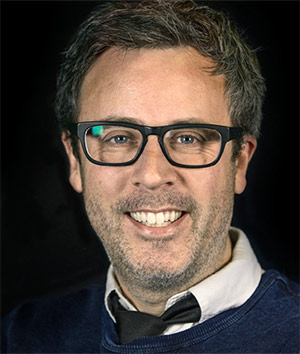
Erik Nordby: [I]t wasn’t easy. It was a lot of trial and error, a lot of stick-to-it-iveness from our director not ever letting go of this idea that he wanted these things to feel real. It was a great collaboration with the Pokémon Company, all of the original creators in Japan. We did a lot of trips to Tokyo to sit down with them, to understand exactly what it was that made a pokémon feel like a pokémon.
What sort of crystallized relatively early on in prep for us was [to have] great respect for the overall silhouettes of the pokémon. We could actually do a log, and as soon as you change that silhouette in some substantial way, it would no longer feel like that pokémon. It would feel like you were doing a disservice to that creature.
And so, there were these moments where we’d be in Tokyo and we’d be sitting down with the original creators, and just really on a napkin they could sketch these extraordinary basic shapes, and you realize that that was the inspiration, that was the base version of that character, and they provided immense resources, these bible character sheets that show you those base sketches.
So we’d start with the silhouettes, and then Rob [Letterman] and I would work with a whole series of concept artists to work through something that felt like it was real, like it could actually exist, and then we would move into animation. Animation then would prove a bunch of other stuff that we didn’t know, and we’d have to go back and change the shapes and the rest of it so we could actually animate it a way that would feel real. That’s how we approached the original design.
Speaking of silhouettes, something particularly interesting is the fact that you kept Pikachu’s tail as a zig-zag shape that acknowledges its 2d source material. That’s something that might have been adapted into a more conventionally naturalistic 3d form. What complications did the tail give when designing Pikachu?
Erik Nordby: You’re the first person to ask about the tail; I love it. It’s just like I was saying — we did try everything. We tried sort of a Golden Retriever tail, which has this longer hair that’s hanging off of it, and we tried to sort of figure out ways that we could keep in that shape, and come up with some sort of real world excuse for why it looked like that, and you sort of convince yourself, “Yeah, that’s it, that works,” and then you would start testing and you have be honest with yourself and go, “No, that doesn’t work, that absolutely doesn’t work.”
That’s when we had to come full circle, go back and go, “Listen, Pikachu is only Pikachu because of the silhouette,” and the silhouette is very emblematic of that tail. The issue is that the tail, in the anime, is always facing you. It doesn’t matter what angle Pikachu is at, the tail is 90 degrees to camera, and that just can’t exist in our world, so we had to build in a series of tests in terms of how thick it is, and how it would move, and as soon as we went too loose with it, it would be end up feeling distracting, and we just sort of test it, test it, test it, and then end up going all the way back to the beginning.
In terms of the process of selecting which pokémon would be transformed into cg out of hundreds, was that based directly on the screenplay or did the design and animation team have any input as to which made the cut?
Erik Nordby: Around 50 or 60 percent of them were in the script. Of those, a lot of them would change along the way. Rob and the writers would write scenes specific to different pokémon, specific to different pokémon talents and different pokémon sizes, and all other considerations in terms of whether they could inhabit the space that the scene was in. As the 30 or 40 of us, who were the main creative force that was doing the prep, would dive into it, we would discover other pokémon and fall in love with them, and then figure out places in the script where they could work.
That process went for almost two straight years, up until about six months before completion. It takes about three months to build a creature in vfx, so about six months before the film was done, we were still adding pokémon that we really believed in. There’s probably about 25 that we started in some way and then had to give up because we couldn’t figure out ways to completely get them into the film, and I look forward to making many more if that ever happens in the future.
With the quantity of creatures that you had to create and different companies and interests to guard, how did the pipeline to create them work? Did you have to get approval from Letterman each time you designed a single pokémon?
Erik Nordby: The pipeline had to become quite regimented. We had upwards of about 25 creature designers around the world. We had one main art director who would organize those creature designers, and they would do concepts first as base 2d [artwork]. We would do about four or five rounds of that with Rob, and as soon as we came up with something that he liked, that would then go to The Pokémon Company in Tokyo, and we would call that Phase 1. Phase 1 approval would come back from Tokyo. It would often have notes; we would address those notes, and then we’d move into Phase 2.

Phase 2 was where we would build it in 3d, very simply build it in 3d, and we would do a series of turn-tables so they could see it from all directions, and Rob could see it, and then that would become a Phase 2 approval, and then Phase 3, which was actually the one I loved the most, was where we would take that really base 3d mesh, and we would rig it and do a series of animation tests. We would learn so much based on those animation tests, because, so much of the character comes to life in the animation.
So once we did the animation tests, we would decide, “Okay, these things aren’t working, the limbs aren’t long enough,” or “The head is too big, it’s going to topple over, we just can’t make the weight feel right.” Based on that we’d then go back to Phase 2 and make modifications. We call that animation base design. Then that would lead to the final Phase, which is essentially the final character. All four of those Phases required approval from Japan, which was extraordinarily difficult to oversee. It’s just self-evident why.
With over 60 characters, and the need for both Rob’s approvals and Tokyo’s approvals, it became this huge, monolithic exercise just to get things approved. Where I think it paid off is that it forced us to do a lot of our work ahead of time. Often times we’re designing those creatures while we’re shooting the movie, but we just couldn’t afford to do that here, so we had to do a lot of homework before we shot the film, which paid off.
In terms of the textures of these creatures and how they interact in a live action world, what was the approach to understand these physical qualities? There are pokémon whose flesh resembles sea creatures, others have fur, they are all different. In recent interviews Rob has mentioned the team used the qualities found in real animals as part of the research.
Erik Nordby: With the exception of Mr. Mime, you can break down every single pokémon into specific animals that we would then reference. We had to do this very scientifically, so we had to take the 2d concept, and we’d create a texture sheet, which is almost like a [color model] sheet, that you would see for classic Disney cartoons, and that texture sheet would show where in the real world those textures would come from.
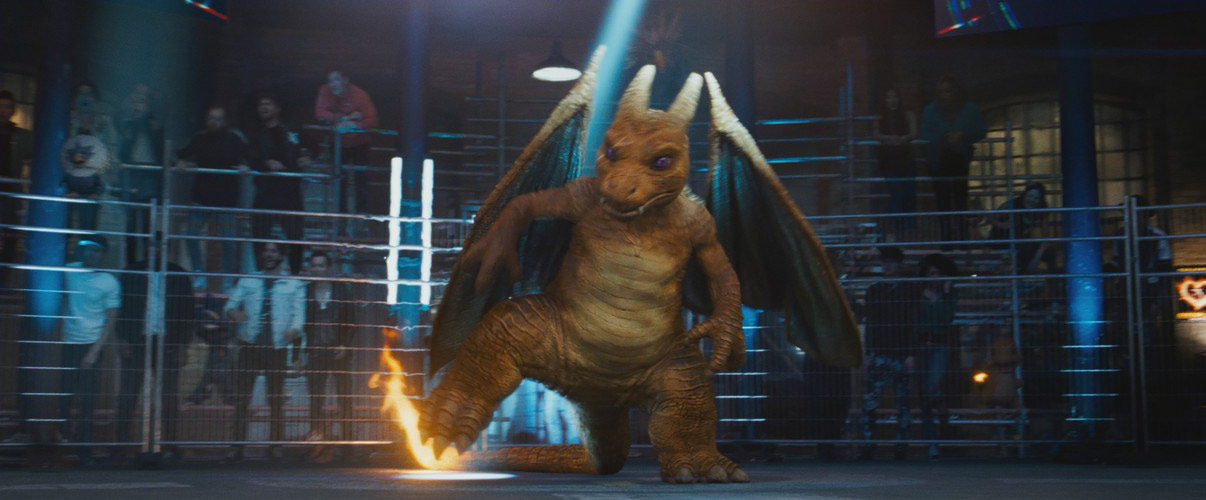
We would then adhere to a specific type of reptile, frog, rock, shell, bird, or a specific feather, a type of jewel, or even bizarre underwater creatures, and every single texture in between. Once we’d gone through that, we would pass that off to the vendors and we would make them prove to us how these textures would work, so they were actually paying attention to the way that light would fall on those different textural references.
If we didn’t have enough of the reference for those textures, we would go and shoot those textures and do our own set of photography. It seems bizarrely simple, but it just requires so much extra work from development, and wrapping everyone’s head around the asset build itself.
The 2d versions of these characters are unified by flat colors, but in this cg world when you are adding so many vfx elements, the result could have turned out less than favorable. That doesn’t happen in Detective Pikachu, and despite the amount of characters and distinct cg components, the world feels cohesive. Was this integration of the colors and the lighting a major part of the process?
Erik Nordby: There were Pantone colors for all of the characters that came directly from the Pokémon Company in Japan, and something that was very difficult for them to wrap their heads around early on was that, even though Pikachu is yellow, if Pikachu is yellow but in a back alley that is filled with red light, he’s going to become quite red, and when he’s in a room that’s quite cool, the colors will also look cool.
Something as simple as that, which we just take for granted, was difficult for them to wrap their heads around, just because of the fact that they wanted to make sure that from a fan point of view, Pikachu would always look like Pikachu. The fact that the human eye is very used to understanding that colors will change depending on the light in the environment was something we had to prove to them.

Another example was in terms of overall texture, the fact that controversially we decided to go with a slightly furry Pikachu, based on the fact that if he didn’t have fur it would look disturbing. So just the basic science of how we actually had to groom that character was about a four to five month process of wrapping our head around how fur could actually be that yellow, how do you come up with fur that could hold that much color, that it’s not actually just one single color, it’s multiple colors of different follicles, that the follicles have different types of hairs — some of them are clear — and how light bounces around and transmits. It was a huge amount of R&D and then a bit of back and forth between the Pokémon Company and us.
Of the characters that did make it onto the screen, are there any that presented you and your team with a peculiar set of difficulties to figure out?
Erik Nordby: They all kind of bring their own level of difficulty. I mention Mr. Mime only because he’s a bit of a standalone. He is made up of inanimate parts as opposed to organic things, so he was initially quite problematic for us to wrap our heads around how we were going to solve that.
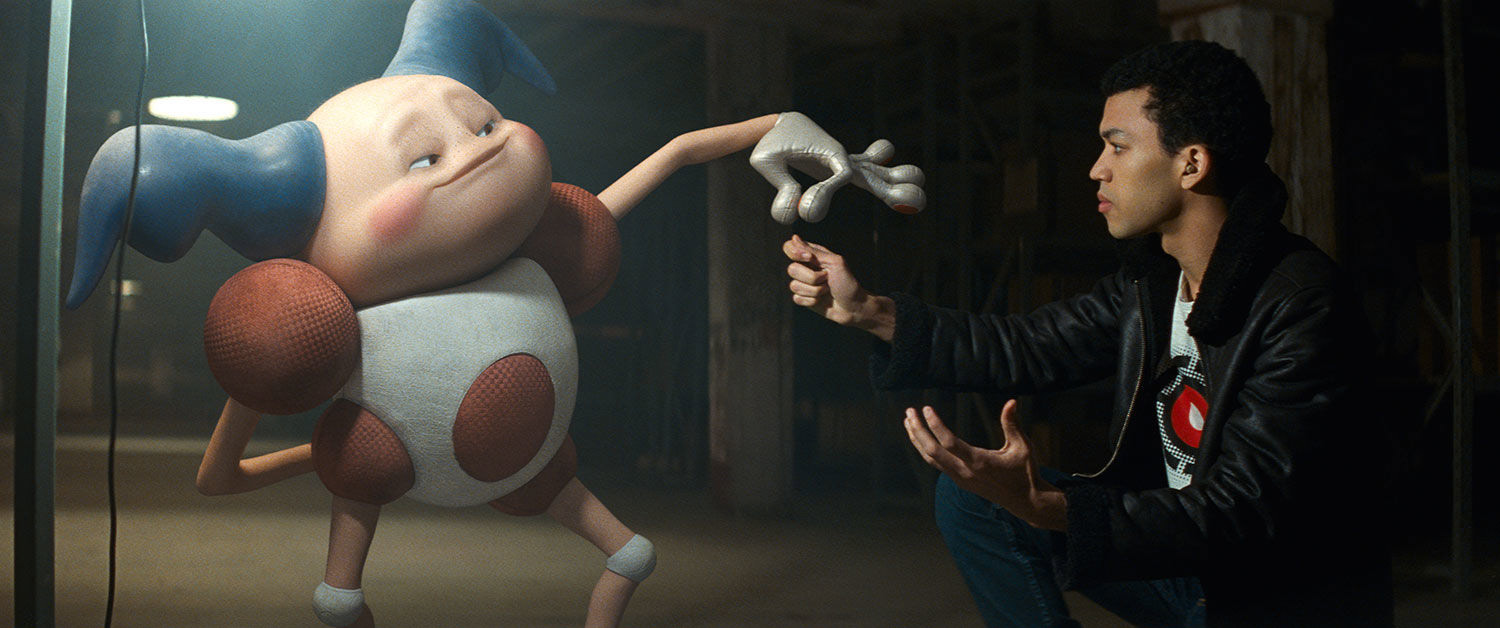
Charizard was another one that was actually more difficult than you would think, only because you are putting a character like Charizard into the hands of a super-talented visual effects team. We’re really good at making dragons, we’ve made dragons look amazing for 25 years, and so what kept happening was that Charizard became superheroic and bizarrely proportioned, with much larger wings and the neck would get longer, and that’s just not Charizard. Charziard’s basically this kind of overweight character with a fat guy in a suit vibe to keep him slightly adorable, even though he’s a big lizard.
We sort of went through these bizarre paths to try to figure these characters out, and then you end of sort of coming back to their origins. Gengar is another one that was unique, because Gengar is essentially just smoke. It appears, it’s corporeal, and then it’s not. So whenever you have to develop something and actually R&D it in effects, that just takes so much more time. Then you have other issues, like for example Slaking can never actually be up — he’s always sleeping, or laying down I should say, not sleeping. Snorlax is the one that’s always sleeping.
